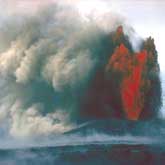A Voggy Day On The Big Island
 On the morning of February 8, 2000, Harry Kim, Director of Hawai`i County Civil Defense, asked radio stations on the Island of Hawai`i to broadcast a special message concerning the thick, acrid haze that had covered the southeastern part of the island for several days. This choking haze was not caused by a forest fire or industrial pollution but by light winds blowing gas emissions from Kilauea Volcano into the area. Best known for its spectacular lava fountains and flows, Kilauea also emits about 2,000 tons of irritating sulfur dioxide gas (SO2) each day during periods of sustained eruption.
On the morning of February 8, 2000, Harry Kim, Director of Hawai`i County Civil Defense, asked radio stations on the Island of Hawai`i to broadcast a special message concerning the thick, acrid haze that had covered the southeastern part of the island for several days. This choking haze was not caused by a forest fire or industrial pollution but by light winds blowing gas emissions from Kilauea Volcano into the area. Best known for its spectacular lava fountains and flows, Kilauea also emits about 2,000 tons of irritating sulfur dioxide gas (SO2) each day during periods of sustained eruption.
Deep inside the volcano, where pressure is high, the SO2 is dissolved in molten rock (magma). When the magma rises toward the surface, where pressure is lower, the gas bubbles out and escapes. Air pollution caused by SO2 and other gases emitted from Kilauea became a frequent problem on the Island of Hawai`i in 1986. Until that time, the volcano's ongoing eruption, which began in 1983, consisted of short, spectacular episodes of lava fountaining about once every 3 weeks. Since mid-1986, the flow of magma to the surface has been more steady, producing a nearly constant but quiet outflow of lava and gas. People in areas downwind of the volcano began reporting a wide range of problems, including reduced visibility, health complaints, and damage to crops. The word 'vog,' an abbreviation for volcanic smog, was coined to identify this form of air pollution, which unfortunately has become a part of everyday life for people in Hawai`i.
Vog is created when SO2 and other volcanic gases combine and interact chemically in the atmosphere with oxygen, moisture, dust, and sunlight over periods of minutes to days. Vog is a visible haze consisting of gas plus a suspended mixture of tiny liquid and solid particles, called aerosol. The aerosol in vog is composed primarily of sulfuric acid and other sulfate compounds. Small amounts of several toxic metals, including selenium, mercury, arsenic, and iridium, have also been found in the volcanic air pollution coming from Kilauea. Far away from the volcano, such as along the Kona coast on the Island of Hawaii's west side, aerosol particles dominate vog, but near Kilauea SO2 gas is a major component of vog. SO2 is a poisonous gas that irritates skin and the tissues and mucous membranes of the eyes, nose, and throat.
Fact Credit
USGS General


